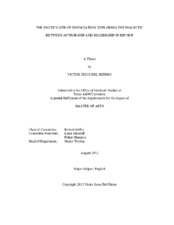| dc.description.abstract | The relationship between authors and readers has been heavily studied in western literatures since the shift between the spoken-subject lost its privileged position to the written author. The struggle for who determines truth has formed a specific dialect that requires either the author or the reader to be silent. Since the acceptance of literary theories like the “death of the author” and “author-function,” we continue to map these concepts on to similar relationships and discourses. Hip-hop culture defies this dialect, instead, based around the concept of the cipher, hip-hop insists on a constant inclusive discourse. Based in African-American traditions of call-and-response, hip-hop is always looking for voices to speak to each other and push the conversation further.
In my thesis, I open up an exploration of the role of an author in hip-hop. Paying specific attention to the rapper, I flesh out the ways western ideas of reading conflate and disrupt the structures of a cipher in hip-hop. Imposing an “author-function” on rappers, displaces the call-and-response relationship that hip-hop thrives on. While hip-hop becomes more prevalent in popular culture, rappers have to learn to navigate within and outside of the immediate hip-hop community. As a case study, I examine the career trajectory of Jay Z. Sean Carter employs the site of enunciation that Jay Z creates to transcend and transform his experiences into a platform for creative expressions as well as lucrative business ventures.
Finally, this thesis serves as an initial inquiry into future research plans to explore rappers as nepantler@s and listeners as “digital griots.” Both of these designations represents important rhetorical spaces that allow hip-hop culture to continue to work within a cipher and promote inclusivity. These future plans build towards creating a possible model for more productive collaboration, education, and activism. | en |


